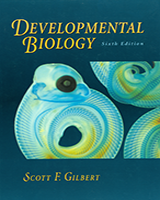By agreement with the publisher, this book is accessible by the search feature, but cannot be browsed.
NCBI Bookshelf. A service of the National Library of Medicine, National Institutes of Health.
Gilbert SF. Developmental Biology. 6th edition. Sunderland (MA): Sinauer Associates; 2000.

Developmental Biology. 6th edition.
Show detailsUrge and urge and urge,
Always the procreant urge of the world.
Out of the dimness opposite equals advance,
Always substance and increase, always sex,
Always a knit of identity, always distinction,
Always a breed of life.
Walt Whitman (1855)*
The final aim of all love intrigues, be they comic or tragic, is really of more importance than all other ends in human life. What it turns upon is nothing less than the composition of the next generation.
A. Schopenhauer
(quoted by C. Darwin, 1871)**
- *
Whitman, W. 1855. “Song of Myself.” In Leaves of Grass and Selected Prose. S. Bradley (ed.), 1949. Holt, Rinehart & Winston, New York, p. 25
- **
Darwin, C. 1871. The Descent of Man. Murray, London, p. 893.
Fertilization is the process whereby two sex cells (gametes) fuse together to create a new individual with genetic potentials derived from both parents. Fertilization accomplishes two separate ends: sex (the combining of genes derived from the two parents) and reproduction (the creation of new organisms). Thus, the first function of fertilization is to transmit genes from parent to offspring, and the second is to initiate in the egg cytoplasm those reactions that permit development to proceed.
Although the details of fertilization vary from species to species, conception generally consists of four major events:
- 1.
Contact and recognition between sperm and egg. In most cases, this ensures that the sperm and egg are of the same species.
- 2.
Regulation of sperm entry into the egg. Only one sperm can ultimately fertilize the egg. This is usually accomplished by allowing only one sperm to enter the egg and inhibiting any others from entering.
- 3.
Fusion of the genetic material of sperm and egg.
- 4.
Activation of egg metabolism to start development.
Contents
- Structure of the Gametes
- Recognition of Egg and Sperm
- Gamete Fusion and the Prevention of Polyspermy
- The Activation of Egg Metabolism
- Fusion of the Genetic Material
- Rearrangement of the Egg Cytoplasm
- Snapshot Summary: Fertilization
- References
- Fertilization: Beginning a new organism - Developmental BiologyFertilization: Beginning a new organism - Developmental Biology
Your browsing activity is empty.
Activity recording is turned off.
See more...